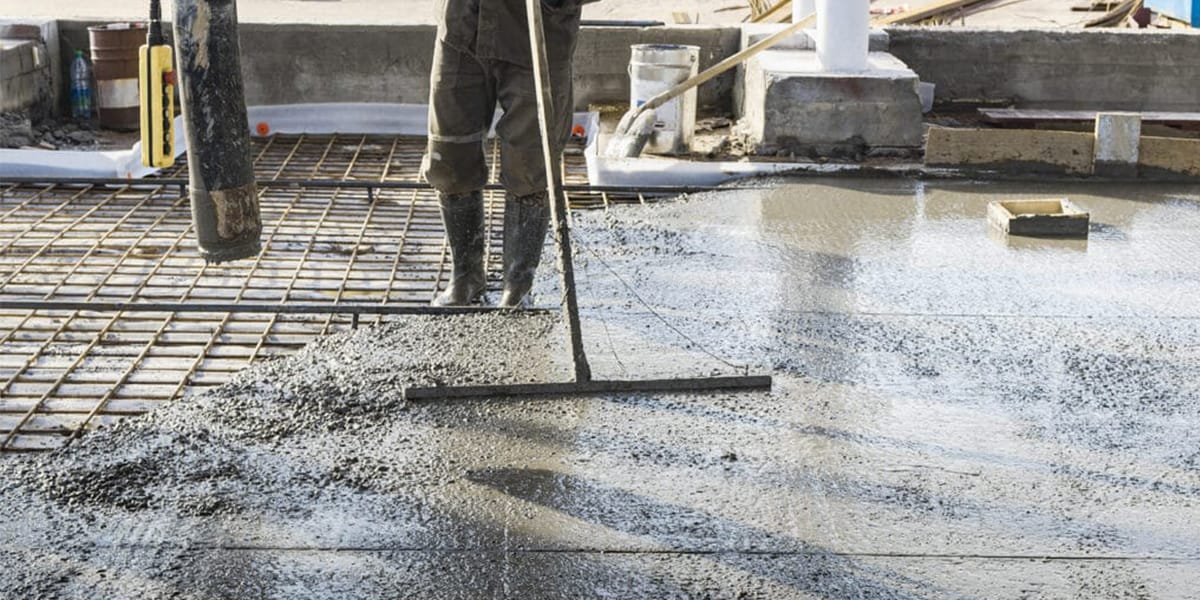
27 Dec What is Concrete Foundation? Types & Benefits Explained
Have you wondered how buildings stay strong through pressure and weather? It’s because of a strong concrete foundation.
A concrete foundation is a solid base that supports a building. It helps spread the weight of the structure evenly and keeps it stable. It prevents the building from sinking or shifting over time.
In this article, we are going to talk about concrete foundations in detail.
Types of Concrete Foundations
There are 2 main kinds of foundations in a construction project. Let us talk about them one by one:
Shallow Foundations
These are a type of foundation built close to the surface of the ground. They are used when the soil near the surface is strong enough to hold the weight of a building. It can handle the weight of buildings in which the structure is less than 6 feet in depth.
These foundations are simpler and less expensive to build. Some of the examples include slab-on-grade or strip foundations.
Deep Foundations
Deep foundations are placed at a greater depth below the ground surface. These transfer the structure’s load to the earth at a certain depth. These are used when the surface soil is not strong enough to support a building.
Hence, the weight is transferred to stronger layers of soil. There are different types of deep foundations, like Buoyancy rafts and Pile foundations.
Functions of a Concrete Foundation
After learning about the types of concrete foundations, let’s look at its main functions:
Providing Stability
The concrete foundations have a high-load bearing capacity. They provide a stable platform for the structure and distribute the heavy loads into the soil underneath.
By providing solid support, concrete foundations also help protect the building from moisture. Additionally, they protect the structure from shifting due to soil movement.
Load Distribution
These foundations can distribute the non-uniform load. For example, a concrete foundation is often used for buildings with uneven weight distribution.
These are large commercial buildings with heavy machinery on one side. The foundation spreads the load across the entire structure, preventing settling.
Ensuring Safety
Buildings need a foundation that can resist corrosion. Plus, it should be able to handle environmental stress. Concrete foundations, because of their high compressive strength, can ensure safety.
Quality concrete is resistant to water, which helps to protect the building from damage, too. In short, it provides structural safety under challenging conditions.
Enhancing Energy Efficiency
Concrete has excellent thermal mass, meaning it can absorb and store heat. It helps to regulate indoor temperatures. This reduces the need for heating or cooling.
Plus, it improves energy efficiency in both residential and commercial buildings. Its ability to maintain a minimal temperature makes it a sustainable choice.
Common Applications of Concrete Foundation
Concrete foundations are used in certain projects because they are strong and can support heavy loads. Usually, it’s used in applications in moderate to high-performance buildings. Here are some of the best applications of this kind of foundation:
Residential Buildings
In residential applications, the foundations serve as the backbone of the structure. They provide a stable base to support the entire building. Some common types of concrete foundations used in homes are slab-on-grade and full basement foundations.
For homes with basements, concrete offers both structural strength and protection against moisture. This ensures the long-term durability and safety of the structure.
Commercial Buildings
Commercial buildings often need foundations that can support significant loads. This can be the weight of heavy machinery or even high pressure. Plus, in specific conditions, they have to sustain through chemical reactions. These foundations ensure that the entire structure stands strong despite harsh conditions.
Infrastructure Projects
You can use concrete foundations in big infrastructure projects like bridges and tunnels. It’s because foundations made of quality concrete can handle environmental pressure.
The strength and durability of concrete allow for long-term stability. This ensures that these critical structures remain safe and functional for many years.
In many cases, foundations built using caissons provide deep anchorage into the soil.
Marine Structures
Marine structures need foundations that are corrosion-resistant. With low-porosity concrete, the concrete foundations can be used in docks and piers. In oil and gas extraction, offshore platforms rely on concrete foundations. It is because these foundations can withstand waves and high winds. Moreover, concrete foundations provide strength to sea walls and jetties during heavy storms.
Public Utility Projects
It’s yet another common application of these kinds of foundations. One fine example of this is water treatment plans. Here, it can withstand both weight and water and provide long-term stability to the structure. Concrete foundations prevent leaks in storage facilities holding gas or liquids.
Pros and Cons of Concrete Foundation
Concrete foundations are a solid choice for many projects, but they have their ups and downs. Here’s a quick look at both:
| Pros | Cons |
| It can support heavy structures. | Initial costs can be high. |
| Lasts for many years with minimal maintenance. | Requires time to cure properly. |
| Can withstand extreme conditions. | It can crack under pressure if not installed correctly. |
| Helps regulate temperature in buildings. | Difficult to transport and handle. |
| Non-combustible, providing better fire safety. | May not work on unstable soil. |
| Requires little upkeep once set. | Concrete production has a high carbon footprint. |
| It can be molded to fit different designs. | Needs waterproofing in wet areas. |
| Not affected by termites or pests. | Requires expertise for proper installation. |
| More stable in seismic zones. | It’s hard to modify once set. |
| Provides strong support for large buildings. | Prone to water damage in some conditions without proper sealing. |
| Resistant to rotting and decay. | Heavy weight can require deeper foundations in some areas. |
| It can be used in a wide variety of projects. | May cause settling issues in shifting soils without proper reinforcement. |
Conclusion
That’s all for a quick guide on concrete foundations. Their strength and durability make them great for residential and infrastructure projects. For custom projects, you can adjust the cement content to get the result you need. However, when making a decision on the types of concrete foundation, it’s suggested to consult an expert.
Looking for professional advice on concrete foundations?
Let New Huilian get you started.
Get in touch with us today!


